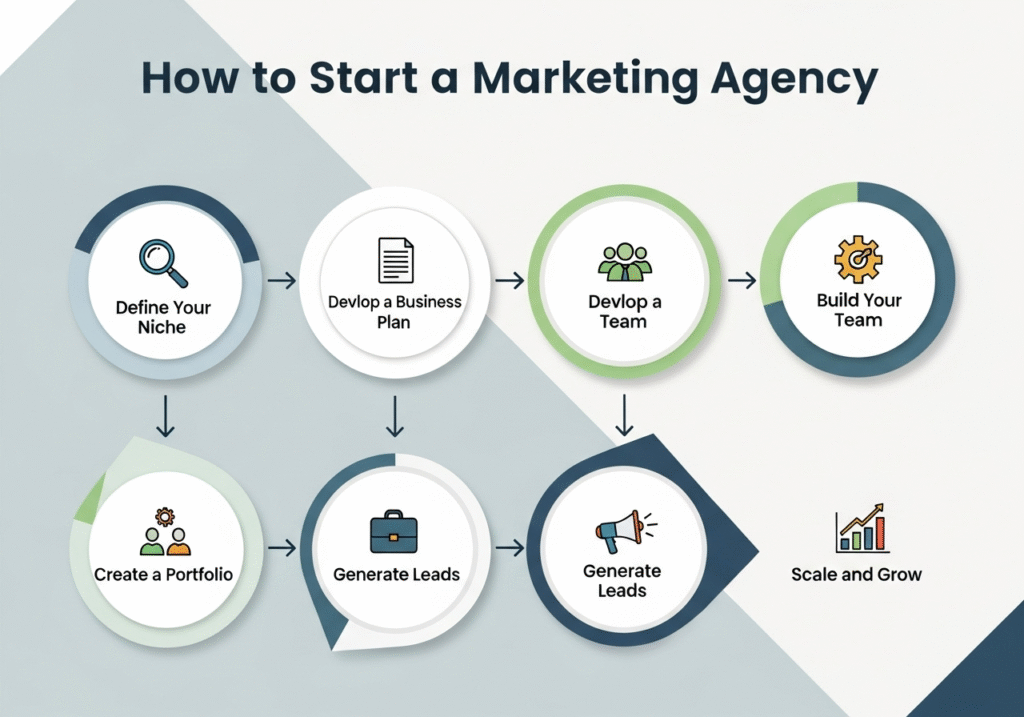Analyzing your competitors’ SEO strategies can unlock powerful insights for your own content marketing efforts. This guide shows digital marketers, SEO professionals, and content strategists how to get a topical map of your competitor’s SEO strategy to identify content gaps and opportunities.
A topical map reveals the content themes and keyword clusters your competitors use to build SEO topical authority. By reverse-engineering their approach, you can discover untapped topics, understand their content strategy, and create a stronger topical clustering SEO framework for your site.
We’ll walk through the essential tools for competitor topical analysis and show you the step-by-step process to map competitor topics effectively. You’ll also learn how to analyze competitor content depth and transform these insights into actionable improvements for your own SEO content gap analysis and strategy.
Understanding Topical Mapping for Competitor SEO Analysis

Define Topical Mapping and Its Role in SEO Strategy
Topical mapping is essentially creating a blueprint of how content topics connect and relate to each other within a specific industry or niche. Think of it as drawing a family tree, but instead of relatives, you’re mapping out topics, subtopics, and related keywords that work together to establish expertise in your field.
When you get topical map of competitor seo strategies, you’re reverse-engineering their content architecture to understand how they’ve organized their knowledge base. This process reveals the strategic thinking behind their content creation, showing which topics they prioritize and how they connect different pieces of content to build authority.
Topical map seo differs from traditional keyword research because it focuses on comprehensive topic coverage rather than individual keyword targeting. Instead of creating isolated blog posts around random keywords, successful sites build interconnected content hubs that demonstrate deep knowledge across related subjects.
The role of topical mapping in SEO strategy extends beyond just content planning. Search engines now evaluate websites based on their topical authority – essentially measuring how well a site covers all aspects of a particular subject. When you understand your competitor’s topical structure, you can identify gaps in your own content strategy and discover new angles for establishing expertise in your industry.
Identify Key Benefits of Analyzing Competitor Content Clusters
Competitor seo analysis through topical mapping provides several strategic advantages that traditional competitive research methods often miss. First, you’ll discover content opportunities that your competitors haven’t fully explored yet. While they might rank well for certain topics, their content clusters often reveal weak spots where you can create more comprehensive coverage.
Understanding competitor content strategy helps you see the bigger picture of their SEO approach. You’ll notice patterns in how they structure their content, which topics they treat as pillar content, and how they support those main topics with related subtopics. This insight allows you to build more strategic content plans rather than randomly creating blog posts.
Another major benefit is uncovering high-value topic areas that drive significant traffic to competitor sites. When you analyze their content clusters, you’ll often find topic combinations that wouldn’t be obvious through regular keyword research. These topic relationships can become the foundation for your own content strategy, helping you target user needs more effectively.
The competitive intelligence gained from topical mapping also reveals seasonal patterns and content timing strategies. You’ll see when competitors publish certain types of content and how they sequence related topics to maximize their impact on search rankings.
Recognize How Topical Authority Impacts Search Rankings
Seo topical authority has become one of the most critical ranking factors in modern search algorithms. Search engines want to see that websites don’t just mention topics briefly but actually demonstrate comprehensive knowledge and expertise across related subject areas.
When search engines evaluate topical authority, they look at how thoroughly a website covers a particular subject. Sites that only scratch the surface of topics rarely achieve strong rankings, while those that dive deep into multiple related aspects tend to perform much better. This is why understanding competitor topical authority helps you identify the depth of content needed to compete effectively.
Topical authority also affects how search engines interpret new content on your site. Once you establish expertise in a particular area through comprehensive topic coverage, new content related to that topic tends to rank faster and higher. This creates a compounding effect where strong topical authority makes future content marketing efforts more effective.
The connection between topical authority and user trust plays a huge role in search rankings. When users find comprehensive, interconnected content that answers multiple related questions, they spend more time on the site and are more likely to return. These user behavior signals reinforce your topical authority in search engine algorithms.
Understand the Connection Between Topic Clusters and User Intent
Topical clustering seo works because it mirrors how users actually think about and search for information. People rarely have just one isolated question about a topic – they typically have a series of related questions that build on each other as they learn more about a subject.
When you analyze competitor topic clusters, you’re essentially mapping out these user intent journeys. You’ll see how competitors guide users from basic awareness-stage questions to more detailed implementation questions, and finally to decision-making content. This user journey mapping becomes invaluable for planning your own content strategy.
Different types of user intent require different approaches to topical clustering. Informational intent might need broad topic clusters that cover multiple aspects of a subject, while commercial intent might require tighter clusters focused on specific product categories or service offerings. Understanding how competitors match their topic clusters to user intent helps you optimize your own approach.
The relationship between topic clusters and user intent also reveals opportunities for internal linking strategies. When you see how competitors connect related topics, you can identify ways to create stronger content relationships that keep users engaged longer and signal topical expertise to search engines.
Essential Tools for Competitor Topical Analysis

Leverage Ahrefs for comprehensive keyword and content analysis
Ahrefs stands out as the powerhouse for competitor seo analysis when building your topical map seo strategy. Start by entering your competitor’s domain into Site Explorer to reveal their complete content ecosystem. The “Top Pages” report shows which topics drive the most traffic, giving you immediate insight into their topical clustering seo approach.
The Content Gap tool becomes your secret weapon here. Compare up to five competitor domains against yours to discover keyword opportunities they’re ranking for while you’re not. This reveals gaps in your competitor content strategy that you can exploit. Look for keywords with decent search volume but manageable difficulty scores – these represent your best opportunities for quick wins.
Dive deeper into their seo topical authority by examining the Keywords Explorer. Filter by their domain to see keyword clusters and related terms they’re targeting. Pay attention to their keyword density across different topics – high concentrations often indicate their primary content pillars.
The Organic Keywords report reveals seasonal trends and content refresh patterns. Watch for keywords where their rankings fluctuate – these signal opportunities where fresh, comprehensive content could outrank them.
Utilize SEMrush to uncover competitor content gaps
SEMrush excels at revealing the strategic thinking behind your competitor seo strategy. The Topic Research tool takes any seed keyword and maps out entire content clusters your competitors are targeting. This creates a visual representation of their topical coverage, perfect for understanding how to build topical map structures similar to theirs.
The Keyword Gap tool compares your keyword portfolio against multiple competitors simultaneously. Filter results by “Missing” to find keywords your competitors rank for but you don’t target at all. These gaps often represent entire content categories you’ve overlooked in your seo content gap analysis.
Brand Monitoring tracks competitor content mentions and backlink acquisition patterns. This reveals which topics generate the most engagement and authority-building opportunities in your niche. Look for recurring themes in their most-shared content – these indicate profitable topic clusters worth replicating.
The Position Tracking tool monitors competitor ranking movements over time. Set up tracking for their top-performing pages to identify content refresh cycles and seasonal optimization patterns. This intelligence helps you time your own content releases for maximum impact.
Extract insights using Screaming Frog for site structure analysis
Screaming Frog reveals the technical backbone supporting your competitor’s topical map for seo success. Configure the crawler to extract title tags, meta descriptions, and heading structures across their entire site. This data shows how they organize topics hierarchically and distribute topical authority through internal linking.
Export the crawl data to analyze their URL structure patterns. Look for directory naming conventions, subdomain usage, and content categorization systems. Many successful sites use URL paths that mirror their topic clusters – /fitness/nutrition/, /fitness/workouts/, /fitness/supplements/ – revealing their topical clustering seo architecture.
The Internal Link analysis uncovers their topic reinforcement strategies. Filter by anchor text to see which keywords they prioritize in internal links. High internal link counts to specific pages often indicate their most important topic clusters and money pages.
Custom extractions can pull schema markup, internal search data, and content freshness signals. Set up extractions for publication dates to identify their content velocity patterns. Fast-publishing competitors in trending topics often signal emerging opportunities for your own competitor keyword research efforts.
Cross-reference this technical data with your Ahrefs and SEMrush findings to build a complete picture of their topical dominance strategy. The combination reveals not just what topics they target, but how they structure and connect content for maximum SEO impact.
Step-by-Step Process to Map Competitor Topics

Identify your main competitors in search results
Start by searching for your primary target keywords on Google and recording which websites consistently appear in the top 10 results. These are your real competitors for topical map SEO, not just companies in your industry. Use tools like SEMrush or Ahrefs to identify competitors ranking for similar keywords in your space.
Look beyond the first page – check positions 11-30 to spot emerging competitors who might be building strong seo topical authority in your niche. Create a list of 5-10 primary competitors who appear most frequently across your core keyword searches. Include both direct competitors and content publishers who rank well for topics relevant to your business.
Don’t forget to check for different types of competitors: some might dominate informational searches while others excel at commercial keywords. This gives you a complete picture of who’s competing for different parts of the search landscape in your market.
Extract competitor URLs and perform content audits
Use crawling tools like Screaming Frog or Sitebulb to extract all URLs from your competitors’ websites. This gives you a complete inventory of their content to work with. Export the data into a spreadsheet and clean it up by removing duplicate URLs, parameter variations, and non-content pages like contact forms or privacy policies.
For each competitor, gather key metrics including:
- Page titles and meta descriptions
- Word count and content type
- Publishing dates and update frequency
- Social shares and backlink counts
- Estimated organic traffic per page
Focus on pages that receive significant organic traffic – these represent their most successful competitor content strategy efforts. Tools like Ahrefs’ Site Explorer can show you which pages drive the most search traffic for each competitor, helping you prioritize which content to analyze first.
Categorize content into topic clusters and themes
Group competitor content into logical topic clusters by analyzing page titles, headings, and main topics covered. Start with broad categories, then break them down into more specific subcategories. For example, a fitness website might have clusters around “weight loss,” “muscle building,” and “nutrition.”
Create a mapping system that shows:
| Topic Cluster | Number of Pages | Traffic Potential | Content Types |
|---|---|---|---|
| Beginner Workouts | 25 | High | How-to guides, videos |
| Nutrition Plans | 18 | Medium | Lists, meal plans |
| Equipment Reviews | 32 | High | Reviews, comparisons |
Look for patterns in how competitors structure their topical clustering seo approach. Some might have deep coverage in specific areas while others spread content across many topics. This reveals their content strategy priorities and where they’re trying to build authority.
Pay attention to content gaps within each cluster – topics they cover extensively versus areas with only surface-level content. These gaps represent opportunities for your own content strategy.
Analyze internal linking patterns between related topics
Map out how competitors connect related content through internal links. Strong seo topical authority sites typically have robust internal linking between pages in the same topic cluster. Use tools like Ahrefs’ Site Audit or manually check how they link between related articles.
Document linking patterns like:
- Hub pages that link to multiple related articles
- Topic silos that keep related content connected
- Cross-cluster linking between complementary topics
- Use of contextual links versus navigation links
Create a visual map showing how their content clusters connect to each other. This reveals their content hierarchy and which topics they consider most important. Strong internal linking patterns often indicate where competitors are trying to build the most search authority.
Look for anchor text patterns in their internal links – this shows which keywords they’re trying to reinforce for specific pages and topics.
Document keyword relationships within each topic cluster
For each topic cluster, extract the primary and secondary keywords that competitors target. Use tools like SEMrush’s Keyword Gap analysis to see which specific terms each piece of content ranks for within a cluster.
Create keyword maps showing:
- Head terms (broad, high-volume keywords)
- Long-tail variations and modifiers
- Related semantic keywords
- Question-based keywords and search intents
Track how competitors distribute keywords across their cluster content. Some might target broad terms on pillar pages while using long-tail keywords on supporting articles. Others might spread keyword targeting more evenly across all cluster content.
This competitor keyword research approach reveals not just what keywords they target, but how they organize their keyword strategy within each topic area. You can spot opportunities where they’re missing keyword variations or where their coverage isn’t comprehensive enough.
Document search intent patterns within each cluster – whether competitors focus more on informational, commercial, or transactional searches for different topics. This helps you understand their business goals for each content area and identify gaps in their competitor seo strategy.
Analyzing Competitor Content Depth and Quality

Evaluate Content Comprehensiveness Across Topic Areas
When diving into competitor SEO analysis, you need to look beyond surface-level metrics and examine how thoroughly your competitors cover each topic cluster. Start by creating a content depth scorecard for each major topic in their topical map. Look at whether they provide beginner, intermediate, and advanced content for each subject area.
Check if competitors answer the full spectrum of questions users might have about a topic. For instance, if they’re targeting “email marketing,” do they cover strategy development, tool selection, automation setup, and performance measurement? Or do they only scratch the surface with basic how-to guides?
Pay attention to how competitors structure their comprehensive coverage. Some create pillar pages that serve as comprehensive guides, while others prefer breaking topics into multiple detailed articles. Document which approach works better for different topic clusters by examining their search rankings and organic traffic patterns.
Assess Keyword Density and Semantic Keyword Usage
Modern SEO topical authority isn’t built on keyword stuffing—it’s about smart semantic keyword integration. Analyze how competitors naturally weave primary and related keywords throughout their content. Use tools like SEMrush or Ahrefs to examine their keyword density patterns and identify semantic keyword clusters they target.
Look for LSI (Latent Semantic Indexing) keywords and topic-related terms your competitors use. This reveals their understanding of search intent and how they’re building topical clustering SEO strategies. Create a spreadsheet mapping their primary keywords against semantic variations and supporting terms.
Notice how competitors balance keyword optimization with readability. The best-performing content typically maintains keyword densities between 1-3% while incorporating dozens of related terms that Google associates with the main topic.
Compare Content Formats and Multimedia Integration
Your competitor content strategy analysis should examine how different content formats perform across various topics. Some competitors might excel with long-form guides, while others dominate with video content or interactive tools.
Document the content formats each competitor uses:
| Content Format | Competitor A | Competitor B | Competitor C |
|---|---|---|---|
| Blog Posts | 70% | 45% | 60% |
| Video Content | 15% | 35% | 20% |
| Infographics | 10% | 15% | 15% |
| Interactive Tools | 5% | 5% | 5% |
Examine their multimedia integration strategies. Do they embed relevant videos, charts, and images that enhance user engagement? Check if they’re using original graphics or stock photos, and note how visual elements support their topical authority building.
Identify Content Gaps in Competitor Topic Coverage
This is where you’ll find your biggest opportunities. Even industry leaders have blind spots in their topical coverage that you can exploit. Use your competitor keyword research to identify topics they’re not addressing or areas where their content feels shallow.
Create a gap analysis matrix showing:
- Topics with high search volume but low competitor coverage
- Subtopics within their main areas that lack depth
- User questions that remain unanswered in their content
- Emerging trends they haven’t addressed yet
Look for patterns in these gaps. Are competitors consistently missing certain audience segments or specific use cases? These discoveries will directly inform how to build topical map strategies that outperform existing content.
Cross-reference competitor content gaps with search trends and question-based keywords from tools like Answer The Public. This approach reveals opportunities where you can establish topical authority in areas your competitors have overlooked or under-served.
Transforming Competitor Insights into Your SEO Strategy

Prioritize high-opportunity topics based on competitor analysis
After mapping your competitor’s topical coverage, you need to identify which opportunities deserve your attention first. Start by creating a spreadsheet that ranks topics based on three key factors: search volume, competitor content quality, and your current authority level in that area.
Look for topics where competitors rank well but their content shows clear weaknesses. Maybe they’ve published a 500-word surface-level article on a complex subject, or their information is outdated. These represent golden opportunities for you to swoop in with better resources.
Pay special attention to topics where multiple competitors are competing but none have established true dominance. When you see rankings constantly shifting between positions 3-8, that signals an opening for a well-crafted piece of content to claim the top spot.
Create a priority matrix that weighs business impact against effort required. Topics that directly support your product or service should get extra points, even if the search volume seems modest. A smaller audience of highly qualified prospects beats massive traffic that doesn’t convert.
Don’t ignore topics where your competitors have thin coverage across their entire content ecosystem. If you spot a subject that only appears once or twice across their entire site, but keyword research shows decent search interest, you’ve found a potential content gap to exploit.
Create superior content that fills identified gaps
Building better content than your competitors requires more than just writing longer articles. Start by analyzing what your competitors missed in their coverage of each topic. Read through their content with a critical eye, noting questions left unanswered, examples that could be clearer, or steps in a process they skipped over.
Your content should address every point your competitors covered, then go several steps further. If they provided 5 tips, you should offer 10-15. If they used basic examples, you should include real case studies with specific data and results. The goal is to make their content feel incomplete by comparison.
Structure your content for maximum user experience. Use clear headings, bullet points, and visual elements to break up text. Include interactive elements like calculators, templates, or checklists that provide immediate value. These features keep visitors on your page longer and encourage social sharing.
Update frequency matters more than most people realize. While your competitors let their content grow stale, you should plan regular updates that keep your information current. Add new examples, refresh statistics, and expand sections based on user feedback and evolving search trends.
Consider different content formats that your competitors haven’t explored. If they only publish blog posts, you might create video tutorials, infographics, or downloadable guides. Multi-format content gives you more opportunities to rank and reach different types of learners.
Develop internal linking strategies that outperform competitors
Your internal linking strategy can give you a significant edge over competitors who treat it as an afterthought. Start by mapping your content topics into logical clusters, then create a hub-and-spoke model where your most comprehensive pieces serve as pillar content linking to related subtopics.
Study how your competitors link between their articles. Most sites use random, opportunistic linking without any real strategy. You can beat them by creating deliberate link pathways that guide users through logical content journeys while distributing link equity strategically.
Build topic-specific content hubs that your competitors lack. If you’re targeting “email marketing,” create a central resource that links to articles about subject lines, automation, list building, and analytics. This clustering approach helps search engines understand your topical authority better than scattered individual articles.
Use anchor text more strategically than your competitors. Instead of generic phrases like “click here” or “read more,” use descriptive anchor text that includes relevant keywords while feeling natural in context. This helps both users and search engines understand what they’ll find on the destination page.
Create content upgrade pathways that keep users engaged longer than competitor sites. Link from beginner content to intermediate and advanced topics, providing clear next steps for users who want to dive deeper. This approach reduces bounce rates and increases time on site, both positive ranking signals.
Monitor your competitors’ internal linking patterns using tools like Screaming Frog or Ahrefs. Look for pages that receive many internal links – these reveal what your competitors consider their most important content. You can then create better versions of these topics and build stronger internal link support around them.

Getting a clear picture of your competitor’s SEO strategy through topical mapping gives you a serious advantage in the search rankings game. By using the right tools and following a systematic approach to analyze their content themes, depth, and quality, you can uncover the exact topics that are driving their organic traffic success. This insight helps you spot content gaps in your own strategy and identify high-value opportunities you might have missed.
The real magic happens when you take these competitor insights and turn them into actionable steps for your own SEO efforts. Don’t just copy what they’re doing – use their topical map as inspiration to create even better, more comprehensive content that serves your audience’s needs. Start mapping your top competitors today, and you’ll soon have a roadmap that guides your content strategy toward better rankings and more organic visibility.



